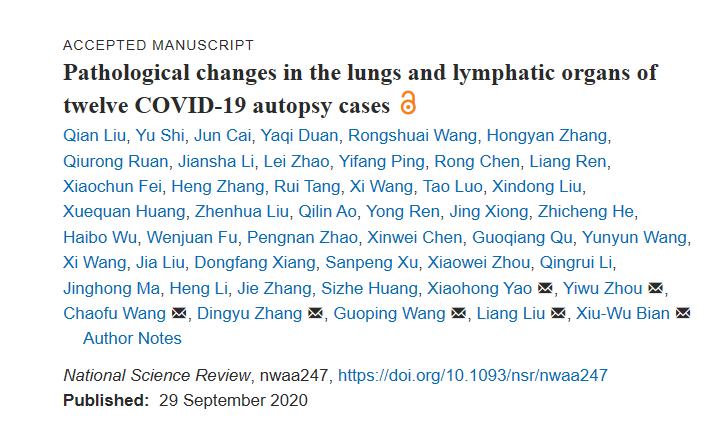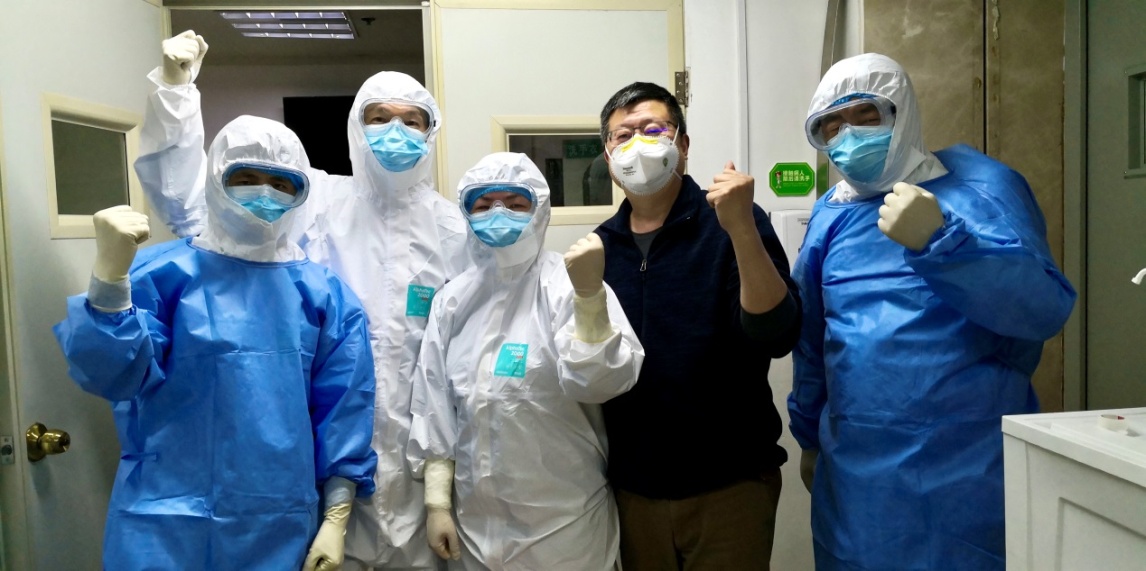Beginning at the end of 2019, the new coronavirus disease (COVID-19) caused by SARS-CoV-2 has become a global pandemic. According to data from Johns Hopkins University, as of now (October 8, 2020), there have been more than 36.06 million confirmed cases of the new crown virus worldwide and 1.05 million deaths, and it is expected to increase further.
On September 30, 2020, the National Science Review (NSR) magazine (latest impact factor 16.693) published an online research paper entitled "Pathological changes in the lungs and lymphatic organs of twelve COVID-19 autopsy cases", this thesis was completed in cooperation with the Department of Forensic Medicine of our school, the Institute of Pathology, Southwest Hospital of Third Military Medical University, the Department of Pathology, Tongji Medical College of Huazhong University of Science and Technology, and Wuhan Jinyintan Hospital. Among them, associate Professor Qian Liu and Professor Liang Ren of our department are the co-first authors of the paper, professor Liang Liu and professor Yiwu Zhou are the co-corresponding authors of the paper, and the Department of Forensic Medicine, Tongji Medical College of Huazhong University of Science and Technology is the first author's unit.
Website for article details:https://academic.oup.com/nsr/advance-article/doi/10.1093/nsr/nwaa247/5912847?searchresult=1

COVID-19 is generally considered to be an acute self-limiting disease characterized by pneumonia, but about 15% of COVID-19 patients (especially those who are older and have their own disease) can quickly develop into a fatal systemic Diseases, such as acute respiratory distress syndrome and severe cardiovascular or kidney damage, in which 5% to 6% of cases may develop into a critical state with high mortality. The study reported the autopsy findings of the lungs and lymphatic organs of 12 COVID-19 decedents, and assessed the histopathological changes, immune cell signature and inflammatory factor expressions in the lungs, spleen and lymph nodes, and found that the major pulmonary alterations included diffuse alveolar damage, interstitial fibrosis and exudative inflammation featured with extensive serous and fibrin exudates, macrophage infiltration and abundant production of inflammatory factors (IL-6, IP-10, TNFαand IL-1β). The spleen and hilar lymph nodes contained lesions with tissue structure disruption and immune cell dysregulation, including lymphopenia and macrophage accumulation. These findings provide pathological evidence that links injuries of the lungs and lymphatic organs with the fatal systematic respiratory and immune malfunction in critically ill COVID-19 patients.

The forensic pathology team headed by Professor Liang Liu in the Department of Forensic Medicine of Tongji Medical College of Huazhong University of Science and Technology has been calling for systematic autopsy since the development of the new coronary pneumonia epidemic. After various efforts, Professor Liang Liu and his team have overcome various difficulties under the conditions permitted by national policies.Starting from February 16, 2020, they took the lead in the world to carry out the first systematic autopsy of cadavers from new coronary pneumonia. The new coronary pneumonia has now been completed.Systematic autopsy of 11 cases of new coronary pneumonia have been completed, and follow-up histopathological work is also being completed. After intensively completing the histopathological examination of 3 cases in the early stage, the team communicated with clinical experts in a variety of ways in time, and reported the autopsy and pathological results to the clinic as soon as possible to help clinical experts improve the treatment plan.
On February 28th, the research team published the "General Observation Report of Autopsy System of New Coronavirus Pneumonia Deaths " in the Journal of Forensic Medicine (Qian Liu is the first co-author, Liang Liu, Yiwu Zhou, and Liang Ren are the co-corresponding authors), which was the world's first case of new coronary pneumonia system autopsy.
On March 4, the "New Coronavirus Pneumonia Diagnosis and Treatment Plan (Trial Seventh Edition)" was jointly issued by the General Office of the National Health Commission and the Office of the State Administration of Traditional Chinese Medicine.The seventh edition absorbed the research results of the autopsy pathology team, and added the "pathological changes" part for the first time.The lungs, spleen and hilar lymph nodes, heart and blood vessels, liver and gallbladder, kidneys, brain tissue, adrenal glands, esophagus, stomach and intestines and other organs are described in general and microscopic views respectively.
The work of the forensic pathology team of our department opened up a precedent for autopsy of new coronary pneumonia and provided a model for colleagues from all over the world. Under the leadership and demonstration effect of Professor Liang Liu’s team, autopsy and pathological research of new coronary pneumonia has gradually progressed, and follow-up provinces and other teams have also started autopsy work.
This research was strongly supported and cooperated by Academician Xiuwu Bian and his team of the Third Military Medical University, Dean Dingyu Zhang and Dr. Chen Rong of Jinyintan Hospital, Professor Guoping Wang and his team of the Department of Pathology of Tongji Medical College, Rongshuai Wang, Guoqiang Qu and Yunyun Wang of Hubei Chongxin Judicial Expertise Center. Systematic autopsy and pathological studies have played a positive role in reducing the mortality of new coronary pneumonia and saving lives!
